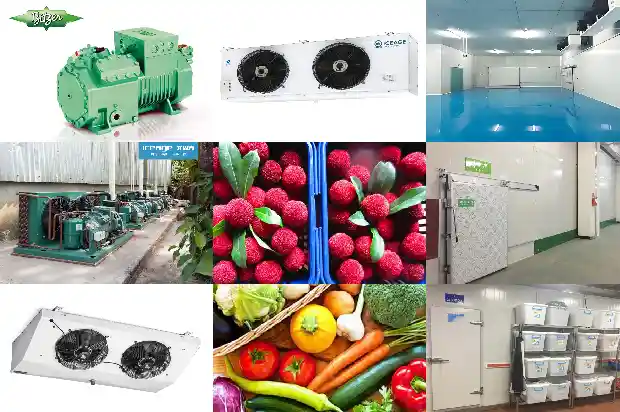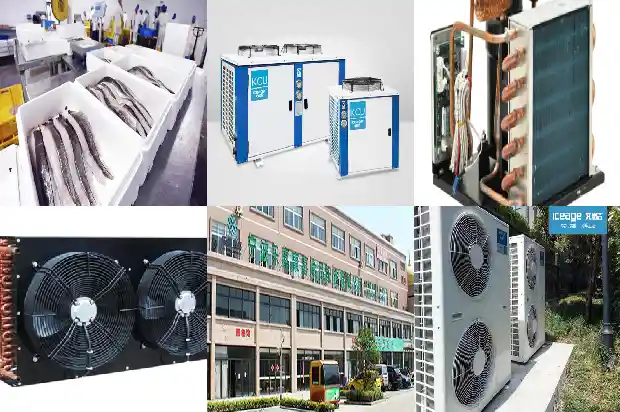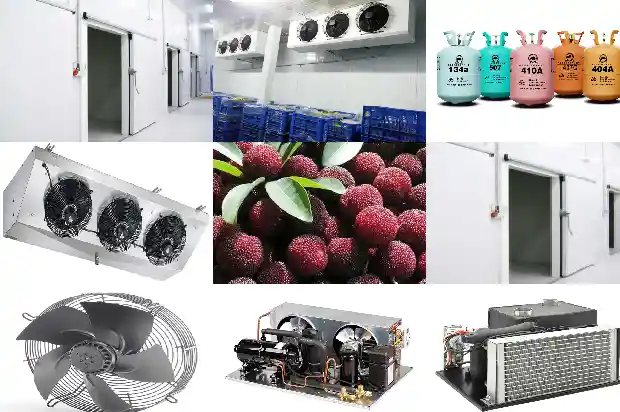Determining the Adequacy of Refrigerant Dosage in Fluorine Refrigeration Systems
2024-09-12
Phenomena when refrigerant is insufficient
① Both the suction pressure and discharge pressure of the compressor are lower than those during normal operation.
② The refrigerating capacity decreases and the refrigeration effect is poor.
③ Bubbles or foams can be seen flowing intermittently on the liquid indicator mirror of the liquid supply pipe.
④ A hissing sound can be heard at the thermal expansion valve, and its loudness is greater than usual.
⑤ There is less dew or frost on the thermal expansion valve, and when the opening degree of the expansion valve is increased, the suction pressure still does not rise.
① Both the suction pressure and discharge pressure of the compressor are lower than those during normal operation.
② The refrigerating capacity decreases and the refrigeration effect is poor.
③ Bubbles or foams can be seen flowing intermittently on the liquid indicator mirror of the liquid supply pipe.
④ A hissing sound can be heard at the thermal expansion valve, and its loudness is greater than usual.
⑤ There is less dew or frost on the thermal expansion valve, and when the opening degree of the expansion valve is increased, the suction pressure still does not rise.
Phenomena when there is too much refrigerant
① In a refrigeration system without a liquid receiver, the condensation pressure will increase because the refrigerant liquid submerges part of the condensation surface area, resulting in a decrease in the efficiency of the condenser.
② In a system with a liquid receiver, the liquid level in the liquid receiver exceeds more than 2/3 of the height of the sight glass.
③ Although the liquid level in the liquid receiver is not high, if the opening degree of the expansion valve is too large, too much liquid will enter the evaporator, the evaporation pressure will rise, the compressor will be severely frosted, and even "cylinder flushing" may occur.
① In a refrigeration system without a liquid receiver, the condensation pressure will increase because the refrigerant liquid submerges part of the condensation surface area, resulting in a decrease in the efficiency of the condenser.
② In a system with a liquid receiver, the liquid level in the liquid receiver exceeds more than 2/3 of the height of the sight glass.
③ Although the liquid level in the liquid receiver is not high, if the opening degree of the expansion valve is too large, too much liquid will enter the evaporator, the evaporation pressure will rise, the compressor will be severely frosted, and even "cylinder flushing" may occur.
Too much or too little refrigerant in the system will prevent the system from operating normally. Refrigerant must be discharged or replenished.
Refrigerant discharge
When discharging the refrigerant, the surrounding environment must be well ventilated and no open flames should be approached, otherwise toxic gases will be generated.
When discharging the refrigerant, the surrounding environment must be well ventilated and no open flames should be approached, otherwise toxic gases will be generated.
- Close the high and low pressure manual valves on the manifold pressure gauge, connect its high and low pressure hoses to the high and low pressure service valves of the compressor respectively, and place the free end of the intermediate pipe on a working rag.
- Slowly open the high pressure manual valve to let the refrigerant discharge from the intermediate hose.
The valve should not be opened too wide, otherwise the frozen lubricating oil in the compressor will flow out with the refrigerant.
- When the pressure gauge reading drops below 0.35 MPa, slowly open the manual valve again to let the refrigerant discharge simultaneously from both the high and low pressure sides.
- Observe the pressure gauge reading.
As the pressure drops, gradually open the high and low pressure manual valves until the readings of the high and low pressure gauges indicate zero.
Refrigerant charging
- Charging at the high pressure end
Charging through the bypass hole (multi-purpose channel) of the compressor discharge valve (high pressure valve), and the refrigerant liquid is added. Its characteristics are safe and fast, and it is suitable for the first charging of the refrigeration system, that is, charging the system after leak detection and vacuum pumping. However, when using this method, it must be noted that the compressor cannot be started during charging (the engine is stopped), and the refrigerant tank is required to be inverted.
Operating steps:
- After the system is vacuumed, close the high and low pressure manual valves on the manifold pressure gauge.

- Connect one end of the intermediate hose to the joint of the refrigerant tank injection valve, open the opening valve of the refrigerant tank, then unscrew the nut at one end of the manifold pressure gauge hose to let the gas overflow for several minutes, and then tighten the nut.
- Unscrew the high pressure side manual valve to the fully open position and invert the refrigerant tank.
- Inject the specified amount of liquid refrigerant from the high pressure side. Close the injection valve of the refrigerant tank and the high pressure manual valve on the manifold pressure gauge, and then remove the instrument.
When charging the refrigerant from the high pressure side to the system, the engine is in a non-starting state (the compressor is stopped), and do not unscrew the low pressure manual valve on the manifold pressure gauge to prevent hydraulic shock.
- Charging at the low pressure end
Charging through the bypass hole (multi-purpose channel) of the compressor suction valve (low pressure valve), and the refrigerant gas is filled. Its characteristic is that the charging speed is slow, and it can be used when the refrigerant is replenished in the system.
Operating steps:
- Connect the manifold pressure gauge to the compressor and the refrigeration tank.
- Open the refrigerant tank, loosen the nut of the intermediate injection hose on the manifold pressure gauge until the sound of refrigerant vapor flowing is heard, and then tighten the nut. Thus, the air in the injection hose is discharged.
- Close the manual high pressure valve, make the refrigerant cylinder stand upright, start the engine to make the air conditioning compressor operate, open the low pressure manual valve to let the gaseous refrigerant enter the compressor from the low pressure side. When the pressure value of the system reaches 0.4 MPa, close the low pressure manual valve and the switch valve of the refrigerant tank.
- Start the engine, turn on the air conditioning switch, and adjust both the blower switch and the temperature control switch to the maximum.
- Open the manual valve on the manifold pressure gauge again to let the refrigerant continue to enter the refrigeration system until the charging amount reaches the specified value.
- After charging the specified amount of refrigerant into the system, observe from the liquid sight window to confirm that there are no bubbles and no excessive refrigerant in the system. Then adjust the engine speed to 2000 r/min and turn the cold blower air volume to the highest gear. If the temperature is 30 - 35 °C, the pressure on the low pressure side in the system should be 0.147 - 0.192 MPa, and the pressure on the high pressure side should be 1.37 - 1.67 MPa.
- After charging is completed, close the low pressure manual valve on the manifold pressure gauge, close the injection valve installed on the refrigerant tank, stop the engine from running, and remove the manifold pressure gauge from the compressor. The action should be quick when removing to avoid excessive refrigerant leakage.
Related Articles
- What to Consider When Replacing R22 with Refrigerant R404A?
- Introduction to Inspection and Handling Methods for Refrigerant Leak in Cold Storage
- Four Combustible and Explosive Refrigerants: Precautions When in Use!
- Characteristics and Differences among Water System, Air System and Refrigerant System
- How to Judge the Refrigerant Charge Amount?
- How to Properly Extract Ammonia Refrigerant during Refrigeration Parts Repair
- Operating Principle and Standard Installation Steps of Multi - split Systems in Refrigerant Air - conditioning Systems
- Sensor for Refrigerant Leak Detection in Cold Chain Transportation
- Why Should Refrigerant Be Filled in Liquid Form? What Are the Filling Methods?
- What are the Cooling and Heating Pressures of an Air Conditioner? How to Calculate the Optimal Refrigerant Quantity?
- Maintenance Methods for Refrigerant Leak in Air - conditioner Outdoor Unit
- Operations and Precautions for Multi - split Air Conditioners: Blowing Debris, Air Tightness, Vacuum Drying, and Refrigerant Charging
- Multi-split air conditioner: Nitrogen charging for welding, pressure maintaining, vacuuming and refrigerant charging
- What Sensors Are Used for Leak Detection of R1234yf, the New Generation of Environmentally Friendly Refrigerant?
- How to Check Refrigerant Leakage in Air Conditioning System?
- Scheme for the Use and Safety of Ammonia Refrigerants
- Precautions for Replacing Refrigeration Compressor Refrigerant Oil
- Introduction to the Relationship between Refrigerants and Cold Storage Temperatures
